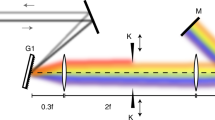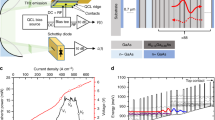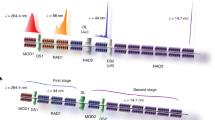Abstract
Lasers are usually described by their output frequency and intensity. However, laser operation is an inherently nonlinear process. Knowledge about the dynamic behaviour of lasers is thus of great importance for detailed understanding of laser operation and for improvement in performance for applications. Of particular interest is the time domain within the coherence time of the optical transition. This time is determined by the oscillation period of the laser radiation and thus is very short. Rigorous quantum mechanical models1,2 predict interesting effects like quantum beats, lasing without inversion, and photon echo processes. As these models are based on quantum coherence and interference, knowledge of the phase within the optical cycle is of particular interest. Laser radiation has so far been measured using intensity detectors, which are sensitive to the square of the electric field. Therefore information about the sign and phase of the laser radiation is lost. Here we use an electro-optic detection scheme to measure the amplitude and phase of stimulated radiation, and correlate this radiation directly with an input probing pulse. We have applied this technique to semiconductor quantum cascade lasers, which are coherent sources operating at frequencies between the optical (>100 THz) and electronic (<0.5 THz) ranges3. In addition to the phase information, we can also determine the spectral gain, the bias dependence of this gain, and obtain an insight into the evolution of the laser field.
This is a preview of subscription content, access via your institution
Access options
Subscribe to this journal
Receive 51 print issues and online access
$199.00 per year
only $3.90 per issue
Buy this article
- Purchase on Springer Link
- Instant access to full article PDF
Prices may be subject to local taxes which are calculated during checkout




Similar content being viewed by others
References
Scully, M. O. & Lamb, W. E. Quantum theory of an optical maser. I. General theory. Phys. Rev. 159, 208–226 (1967)
Haken, H. Cooperative phenomena in systems far from thermal equilibrium and in nonphysical systems. Rev. Mod. Phys. 47, 67–121 (1975)
Faist, J. et al. Quantum cascade laser. Science 264, 553–556 (1994)
Bennet, W. R. Hole burning effect in a He-Ne optical maser. Phys. Rev. 126, 580–593 (1962)
Rigrod, W. W. Gain saturation and output power of optical masers. J. Appl. Phys. 34, 2602–2609 (1963)
Osgood, R., Eppers, W. & Nichols, E. An investigation of the high-power CO laser. IEEE J. Quant. Electron. QE-6, 145–154 (1970)
Crowe, W. & Ahearn, W. F. Semiconductor laser amplifier. IEEE J. Quant. Electron. QE-2, 283–289 (1966)
Diels, J.-C. & Rudolph, W. Ultrashort Laser Pulse Phenomena: Fundamentals, Technique, and Applications on a Femtosecond Time Scale (Academic, San Diego, 1996)
Wu, Q. & Zhang, X.-C. Ultrafast electro-optic field sensor. Appl. Phys. Lett. 68, 1604–1606 (1996)
Huber, R. et al. How many-particle interactions develop after ultrafast excitation of an electron-hole plasma. Nature 414, 286–289 (2001)
Huber, R., Kaindl, R. A., Schmid, B. A. & Chemla, D. S. Broadband terahertz study of excitonic resonances in the high-density regime in GaAs/Al x Ga1–x As quantum wells. Phys. Rev. B 72, 161314 (2005)
Huber, R. et al. Stimulated terahertz emission from intraexcitonic transitions in Cu2O. Phys. Rev. Lett. 96, 017402 (2006)
Koehler, R. et al. Terahertz semiconductor-heterostructure laser. Nature 417, 156–159 (2002)
Walther, C., Scalari, G., Faist, J., Beere, H. & Ritchie, D. Low frequency terahertz quantum cascade laser operating from 1.6 to 1.8 THz. Appl. Phys. Lett. 89, 231121 (2006)
Taflove, A. Computational Electrodynamics: The Finite-Difference Time-Domain Method (Artech House, Boston, 1995)
Ziolkowski, R. W., Arnold, J. M. & Gogny, D. M. Ultrafast pulse interactions with two-level atom. Phys. Rev. A 52, 3082–3094 (1995)
Kröll, J. et al. Longitudinal spatial hole burning in terahertz quantum cascade lasers. Appl. Phys. Lett. (in the press)
Faist, J., Capasso, F., Sirtori, C., Sivco, D. L. & Cho, A. Y. in Intersubband Transitions in Quantum Wells: Physics and Device Applications II (eds Liu, H. C. & Capasso, F.) 1–83 (Academic, London, 2000)
Alton, J. et al. Buried waveguides in terahertz quantum cascade lasers based on two-dimensional plasmon modes. Appl. Phys. Lett. 86, 071109 (2005)
Barbieri, S. et al. 2.9 THz quantum cascade lasers operating up to 70 K in continuous wave. Appl. Phys. Lett. 85, 1674–1676 (2004)
Kohen, S., Williams, B. & Hu, Q. Electromagnetic modeling of terahertz quantum cascade laser waveguides and resonators. J. Appl. Phys. 97, 053106 (2005)
Baltuska, A. et al. Attosecond control of electronic processes by intensive light fields. Nature 421, 611–615 (2003)
Nuss, M. C. & Orenstein, J. in Millimeter and Submillimeter Wave Spectroscopy of Solids (ed. Gruener, G.) Ch. 2 (Springer, Berlin, 1998)
Zhang, X.-C., Hu, B. B., Darrow, J. T. & Auston, D. H. Generation of femtosecond electromagnetic pulses from semiconductor surfaces. Appl. Phys. Lett. 56, 1011–1013 (1990)
Acknowledgements
We are grateful to D. P. Kelly for comments on the presentation of the manuscript. We acknowledge financial support from the European Commission under the Integrated Project TeraNova funded by the IST directorate, and from the Austrian Science Fond (FWF) under the project Advanced Light Sources (ADLIS).
Author information
Authors and Affiliations
Corresponding author
Ethics declarations
Competing interests
The authors declare no competing financial interests.
Supplementary information
Supplementary Figures
The file contains Supplementary Figures S1-S2 with Legends. (PDF 335 kb)
Rights and permissions
About this article
Cite this article
Kröll, J., Darmo, J., Dhillon, S. et al. Phase-resolved measurements of stimulated emission in a laser. Nature 449, 698–701 (2007). https://doi.org/10.1038/nature06208
Received:
Accepted:
Issue Date:
DOI: https://doi.org/10.1038/nature06208
This article is cited by
-
Field-resolved high-order sub-cycle nonlinearities in a terahertz semiconductor laser
Light: Science & Applications (2021)
-
Nanoplasma-enabled picosecond switches for ultrafast electronics
Nature (2020)
-
Electro-optic sampling of near-infrared waveforms
Nature Photonics (2016)
-
Direct Nanoscale Imaging of Evolving Electric Field Domains in Quantum Structures
Scientific Reports (2014)
-
Terahertz laser frequency combs
Nature Photonics (2014)
Comments
By submitting a comment you agree to abide by our Terms and Community Guidelines. If you find something abusive or that does not comply with our terms or guidelines please flag it as inappropriate.



